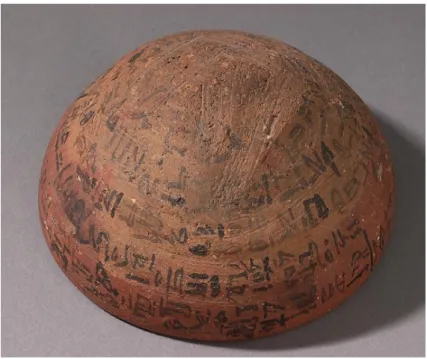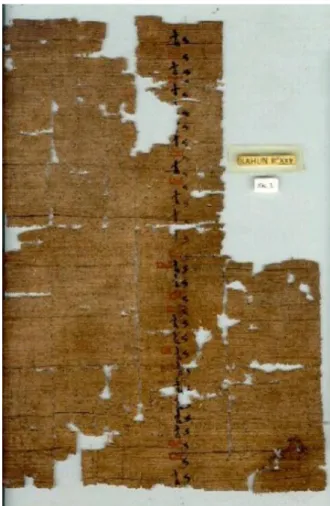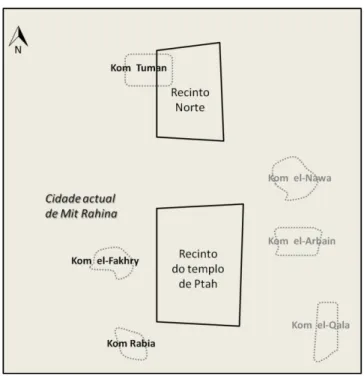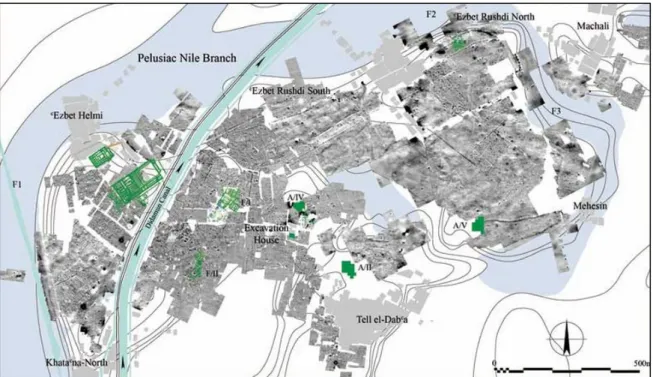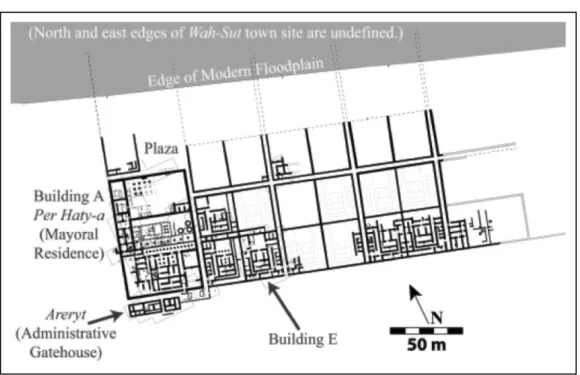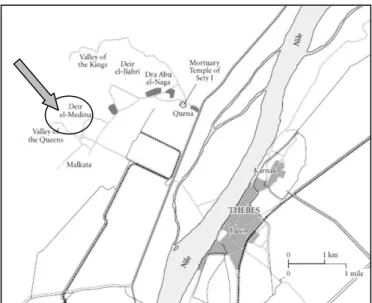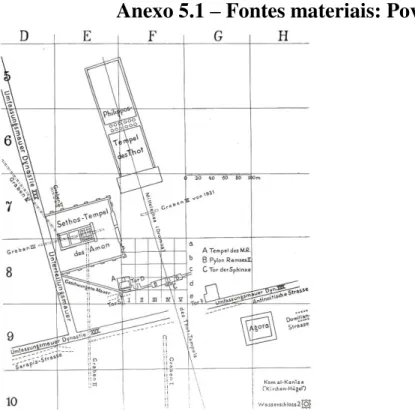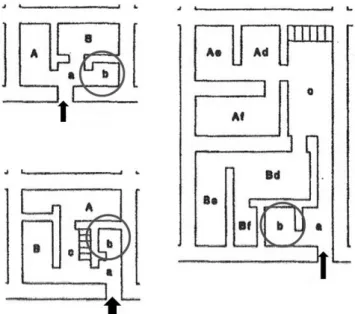i
Anexo 1 - Cronologia
ii NAQADA III (ou “Dinasta 0”) c. 3200 - 3000
(Fim do período Pré-dinástico)
PERÍODO ARCAICO (c. 3000 – 2686 a.C.)
Dinastia I c. 3000 – 2890 a.C.
Aha Djer Djet Den Rainha Merneith Anedjib Semerkhet Qa’a
Dinastia II c. 2890 – 2686 a.C.
Hetepsekhemwy Raneb Nynetjer Weneg Sened Peribsen Khasekhemwy
IMPÉRIO ANTIGO (c. 2686 – 2160 a.C.)
Dinastia III c. 2686 – 2613
Nebka c. 2686 – 2667
Djoser c. 2667 – 2648
Sekhemkhet c. 2648 – 2640
Khaba c. 2640 – 2637
Sanakht?
Huni c. 2637 - 2613
Dinastia IV c. 2613 – 2494
Sneferu c. 2613 – 2589
Khufu (= Queops) c. 2589 – 2566
Djedefra (= Radjedef) c. 2566 – 2558
Khafra (= Quefrem) c. 2558 – 2532
Menkaura (= Mykerinos) c. 2532 – 2503
Shepsekaf c. 2503 – 2498
Dinastia V c. 2494 – 2345
Userkaf c. 2494 – 2487
Sahura c. 2487 – 2475
Anexo 1 - Cronologia
iii
Shepseskara c. 2455 – 2448
Ranefreref c. 2448 – 2445
Nyuserra c. 2445 – 2421
Menkauhor c. 2421 – 2414
Djedkara c. 2414 – 2375
Unas c. 2375 – 2345
Dinastia VI c. 2345 – 2181
Teti c. 2345 – 2323
Userkara (usurpador) c. 2323 – 2321
Pepy I c. 2321 – 2287
Merenra c. 2287 – 2278
Pepy II c. 2278 – 2184
Nitiqret c. 2184 – 2181
Dinastias VII e VIII c. 2181 – 2160
(Numerosos reis)
I PERÍODO INTERMÉDIO (c. 2160 – 2055 a.C.)
Dinastias IX e X c. 2160 – 2025
(Governantes heracleopolitanos) Khety (Merybra)
Khety (Nebkaura) Khety (Wahkara) Merykara
Dinastia XI c. 2125 – 2055
(Governantes tebanos)
Intef I (Sehertawy) c. 2125 – 2112
Intef II (Wahankh) c. 2112 – 2063
Intef III (Nakhtnebtepnefer) c. 2063 – 2055
IMPÉRIO MÉDIO (c. 2055 – 1650 a.C.)
Dinastia XI c. 2055 – 1985
Mentuhotep II (Nebhepetra) c. 2055 – 2004
Mentuhotep III (Sankhkara) c. 2004 – 1992
Mentuhotep IV (Nebtawyra) c. 1992 – 1985
Dinastia XII c. 1985 – 1773
Amenemhat I c. 1985 – 1956
Senuseret I c. 1956 – 1911
Amenemhat II c. 1911 – 1877
Senuseret II c. 1877 – 1870
Anexo 1 - Cronologia
iv
Amenemhat III c. 1831 – 1786
Amenemhat IV c. 1786 – 1777
Rainha Sobekneferu c. 1777 – 1773
Dinastia XIII (De c. 1773 até após c. 1650)
Wegaf Sobekhotep II Ikhernefet Neferhotep Ameny-intef-amenemhat Hor Khendjer Sobekhotep III Neferhotep I Sahathor Sobekhotep IV Sobekhotep V Ay Dinastia XIV
(Vários reis, talvez contemporâneos com as dinastias XIII e XV)
II PERÍODO INTERMÉDIO (c. 1650 – 1550 a.C.)
Dinastia XV (Hyksos) c. 1650 – 1550
Salitis Khyan Apepi Khamudi
Dinastia XVI c. 1650 – 1580
(Reis tebanos contemporâneos com a dinastia XV)
Dinastia XVII c. 1580 – 1550
Rahotep Sobekemsaf I Intef VI Intef VII Intef VIII Sobekemsaf II Siamun ? Taa
Anexo 1 - Cronologia
v IMPÉRIO NOVO (c. 1550 – 1069 a.C.)
Dinastia XVIII c. 1550 – 1295
Ahmose c. 1550 – 1525
Amenhotep c. 1525 – 1504
Tutmés I c. 1504 – 1492
Tutmés II c. 1492 – 1479
Tutmés III c. 1479 – 1425
Rainha Hatsepshut c. 1473 – 1458
Amenhotep II c. 1427 – 1400
Tutmés IV c. 1400 – 1390
Amenhotep IV (Akhenaten) Neferneferuaten
c. 1352 – 1336 c. 1338 – 1336
Neferneferuaten c. 1338 – 1336
Tutankhamun c. 1336 – 1327
Ay c. 1327 – 1323
Horemheb c. 1323 – 1295
Dinastia XIX c. 1295 – 1186
Ramsés I c. 1295 – 1294
Seti I c. 1294 – 1279
Ramsés II c. 1279 – 1213
Meremptah c. 1213 – 1203
Amenmessu c. 1203 – 1200?
Seti II c. 1200 – 1194
Siptah c. 1194 – 1188
Rainha Tausret c. 1188 – 1186
Dinastia XX c. 1186 – 1069
Sethnakht c. 1186 – 1184
Ramsés III c. 1184 – 1153
Ramsés IV c. 1153 – 1147
Ramsés V c. 1147 – 1143
Ramsés VI c. 1143 – 1136
Ramsés VII c. 1136 – 1129
Ramsés VIII c. 1129 – 1126
Ramsés IX c. 1126 – 1108
Ramsés X c. 1108 – 1099
Ramsés XI c. 1099 – 1069
Dinastia XXI c. 1069 – 945
Smendes c. 1069 – 1043
Amenemnisu c. 1043 – 1039
Psusennes I c. 1039 – 991
Amenemope c. 993 – 984
Osorkon, o velho c. 984 – 978
Siamun c. 978 – 959
Anexo 1 - Cronologia
vi
Dinastia XXII c. 945 – 715
Sheshonq I Osorkon I Takelot I Osorkon II Takelot II Sheshonq III Pimay Sheshonq V Osorkon IV
Dinastia XXIII c. 818 – 715
(Reis locais contemporâneos com as dinastias XX, XXIV e início da XX)
Dinastia XXIV c. 727 – 715
Bakenrenef (Bocchoris) c. 720 – 715
Dinastia XXV c. 747 – 656
Piy c. 747 – 716
Shabaqo
Osorkon II c. 716 – 702
Shabitqo c. 702 – 690
Taharqo c. 690 – 664
Tanutamani c. 664 – 656
ÉPOCA BAIXA (c. 664 – 332 a.C.)
Dinastia XXVI (Saís) c. 664 – 525
(Nekau I, sob os assírios) c. 672 – 664
Psamtek I c. 664 – 610
Nekau II c. 610 – 595
Psamtek II c. 595 – 589
Apriès c. 589 – 570
Ahmose II c. 570 – 526
Psamtek III c. 526 – 525
Dinastia XXVII (Pérsia) c. 525 – 404
Cambyses c. 525 – 522
Darius I c. 522 – 486
Xerxes I c. 486 – 465
Artaxerxes I c. 465 – 424
Darius II c. 424 – 405
Artaxerxes II c. 405 – 359
Dinastia XXVIII (Saís) c. 404 – 399
Amyrtaios c. 404 – 399
Anexo 1 - Cronologia
vii
Neferites I c. 399 – 393
Hakor (Achoris) c. 393 – 380
Neferites II c. 380
Dinastia XXX c. 380 – 343
Nectanebo I c. 380 – 342
Teos c. 362 – 360
Nectanebo II c. 360 – 343
II Dominação Persa (Dinastia XXXI?) c. 343 – 332
Artaxerxes III Ochus c. 343 – 338
Arses c. 338 – 336
Darius III Codoman c. 336 – 332
Dinastia XXXI ? c. 338 – 336
Khababash (rebelde) c. 338 – 336
PERÍODO HELENÍSTICO (c. 332 – 30 a.C.) Dinastias macedónias
PERÍODO ROMANO (c. 30 a.C. – 395 d.C.) Província romana
Cronologia adaptada a partir da obra:
Anexo 2
–
Fontes Textuais
Anexo 2.1 - Decreto oracular em forma de amuleto L.1 (P. BM 10083)
viii Recto: “[Khons-]unnekhen and Khons-pairsekheru, those two great living baboons who 1
rest on the right and left of Khons in Thebes Neferhotep and who are those who issue book 2
of death and life. We shall keep her safe from Sakhmet and her son. We shall keep her safe 3
from leprosy, from blindness, and from the Udjat-eye (?) throughout (her) whole lifetime. 4
We shall keep her safe from the seven stars of the Great Bear and we shall keep her safe 5
from the star which falls from the sky and strikes one down. We shall keep her safe from 6
the Ennead of the Upper Egyptian On; we shall keep her safe from their abominations; we 7
shall cause them to be content because of her and cause them to answer her prayers. We 8
shall keep her safe from the books of the beginning of the year and from the books of the 9
end of the year. We shall keep her safe from every (kind of) death, from every (kind of) 10
illness, from every (kind of) accusation, from every (kind of) wrong, from every (kind of) 11
disorder, from every (kind of) frustration, from every (kind of) unpleasant word, from every 12
(kind of) harsh word, from every (kind of) mean word, from every (kind of) mockery. We 13
shall keep her safe from every evil..., from every evil eye, from every evil glance, from 14
every evil injury, and from every evil colour. We shall keep her safe from the 15
manifestations of Amun, Mut, Khons, Amenemope, Mont and Maet. We shall keep her safe 16
from a harsh oracle and a harsh word. We shall keep her safe from the gods who seize 17
someone in a flight (?), from the gods who seize someone by capture (?), from the gods 18
who find someone in <the> country and kill him in the town or vice versa. We shall keep 19
her safe from every god and every goddess who assume manifestations when they are not 20
appeased. We shall keep her safe from the gods who seize someone instead of someone 21
(else). We shall keep her safe from the Great Noble in Heliopolis. We shall keep her safe 22
from every action of a ḫ3y.ty-demon and from every action of a šm3.y-demon. We shall 23
keep her safe from every malady and from every fever. We shall cause strength to flourish 24
in every limb of hers. We shall keep her safe from every god and every goddess of the 25
entire land, in heaven, on earth, in the South, in the North, in the West and in the East. We 26
shall keep her safe from a wrecking of the heart and from a sinking of the heart. We shall 27
open her mouth to speak. We shall keep her safe from harm on every kind of pilgrimage 28
which she may make, in every sanctuary which she may enter, and every place to which 29
she may go. We shall guard her at midday, we shall keep watch (over) her at night, and we 30
Anexo 2.1 - Decreto oracular em forma de amuleto L.1 (P. BM 10083)
ix om the gods of the decade who return to their fellow gods. We shall keep her safe from 32
every šm3.y-demon and we shall keep her safe from any bad confusion in speech. We shall 33
keep her safe <on> (board) ship, on the desert-edge, and on any kind of journey which she 34
may make in (?) any place she wishes. We shall provide everything that is good for her, 35
every... that is good and a happy childhood.” 36
Verso: “... [We shall keep healthy her hands and] their ten fingers. We shall keep 37
healthy her sides. We shall keep healthy abdomen. We shall keep healthy her pudenda (?). 38
We shall keep healthy her rectum. We shall keep healthy her entire abdomen. We shall 39
keep healthy her thighs and shins. We shall keep healthy her ten toes. We shall keep 40
healthy her body and all her limbs from her head to the soles of her feet. Mont-Re-41
Harakhty, lord of the Thebes, who is residing in the Upper Egyptian On, [said] – Inyt, who 42
is residing in the Upper Egyptian On, these great gods, the eldest who were the first to 43
come-into-existence, [said]: “we shall keep safe our servant and our offspring(?) 44
Buiruḥarkhons, whose mother is Djedkhons. We shall keep her safe from demons of a 45
canal, from a demon of a well, from a demon of a lake, from demon of (a pool) left (by the 46
inundation), from a male demon and from a female demon, from a demon of her father and 47
her mother and from a demon of the relatives of her father and the relatives of her mother. 48
We shall propitiate them for her and we shall preserve her from them throughout her 49
whole lifetime. We shall keep her safe from the magic of a Syrian, from the magic of a 50
Nubian, from the magic of a Libyan, from the magic of the people of Egypt, from the magic 51
of a warlock and a witch and from all magic of every kind. We shall keep her safe from 52
mššw.t, from herpes, from tnmm.t, from ḥmk.ṯ, from t3wrrw (?) and from pš. We shall keep 53
her safe any internal ailment in the abdomen and from sickness which has (ever) 54
happened. We shall bring Amun to her at this time. We shall not <allow> anyone to stand 55
up before her. We shall bring Nekhbet to her when she is propitiated. Thus said <they>, 56
namely the great gods, the eldest who were the first to come-into existence: “As regards 57
every good thing which has been included in this oracle as well as those (things) the 58
inclusion of which has been forgotten, they are like those (things) which are placed before 59
us daily, we shall make them beneficial (to) our servant Buiruḥarkhons, whose mother is 60
Djedkhons. We shall (cause her) to conceive male children and female children, we shall 61
cause her to let <them> go forth, we shall cause <her> to send them away and they will 62
report back to her. We shall provide her estate with cattle, with goat(s), with male-servants 63
and female servants, with barley, with emmer, with copper and with apparel.” 64
Anexo 2.2
–
Fontes Textuais: imagens
x Fig. 1 – Taça do Louvre. Carta de uma mãe a um filho falecido.
© Musée du Louvre _C. Décamps_ E 6134
Anexo 2.2
–
Fontes Textuais: imagens
xi Fig. 3 – Calendário de Dias fastos e nefastos do Império Médio
© Petrie Museum of Egyptian Archaeology, University College London _ UC 32192
Fig. 4 – Papiro Médico de Londres
Anexo 2.2
–
Fontes Textuais: imagens
xii Fig. 5
Decreto Oracular em Forma de Amuleto
© The Trustees of the British Museum _BM 10321
Fig. 6
Decreto Oracular em Forma de Amuleto
© Musée du Louvre _ C. Décamps _ E 8083
Fig. 7
Decreto Oracular em Forma de Amuleto
Anexo 2.2
–
Fontes Textuais: imagens
xiii Fig. 9
Estela de Metternich – Estela de Hórus sobre os crocodilos © The Metropolitan Museum of Art, Fletcher Fund, 1950 (50.85)
Fig. 8.A Fig. 8.B Fig. 8.C Estelas de Hórus sobre crocodilos
© Museu do Louvre _ C. Décamps
Anexo 2.2
–
Fontes Textuais: imagens
xiv
Fig. 10.A Fig. 10.B
Fig. 10.C
Estela dedicada a Taueret e Hathor – Casa VI – Bairro SO
A: Imagem da página do caderno de B. Bruyère onde a estela foi desenhada – Arquives de Bernard Bruyère - MS_2004_0156_009
B: Reprodução da estela na obra B. Bruyère, Rapport sur les fouilles de Deir el-Médineh (1934 - 1935), Fouilles de l'Institut français d'archéologie orientale 16, Cairo,
Institut français d'archéologie orientale, 1939, p. 335, Fig. 306. © Institut français d'archéologie orientale
Anexo 2.2
–
Fontes Textuais: imagens
xv Fig. 11 - Lintel de altar – Casa II – Bairro SE
In B. Bruyère, Rapport sur les fouilles de Deir el-Médineh (1934 - 1935), Fouilles de l'Institut français d'archéologie orientale 16, Cairo, Institut français d'archéologie
orientale, 1939, p. 267, Fig. 139.
Fig. 12 – Estela 3ḫ iḳr n R’ de Khonsu – Casa II – Bairro SO © Musée du Louvre _ RMNH Lewandowski_ E 16344
Fig. 13 - Figura feminina com criança.
Um dos três exemplos conhecidos com inscrição. Achada num túmulo do Império Médio.
Anexo 3 - Mapa do Egipto antigo com os povoados considerados no
estudo
Anexo 4 - Base de dados com as fontes materiais para o estudo da
Religião Doméstica
Anexo 4.1
–
Imagem da base de dados em tabelas
Anexo 4.2
–
Exemplo de ficha de inserção
Anexo 5
–
Fontes Materiais
Anexo 5.1
–
Fontes materiais: Povoados
xx Fig. 14 –Planta da “Grande Abidos”
In http://www.penn.museum/sites/expedition/the-archaeology-of-south-abydos/ [10 Junho 2014]
Anexo 5.1
–
Fontes materiais: Povoados
xxi Fig. 16 – Planta do forte de Mirgissa
In D. Dunham, Second cataract forts: Uronarti, Shalfak, Mirgissa, Vol. II, Boston, Museum of Fine Arts, 1967, Mapa XVII.
Fig. 17 – Planta do forte de Uronarti
Anexo 5.1
–
Fontes materiais: Povoados
xxii Fig. 18 – Planta da zona de Lahun
Fig. 19 – Planta de Lahun
Anexo 5.1
–
Fontes materiais: Povoados
xxiii Fig. 20 – Planta de Mênfis
Destacamos as duas zonas consideradas no estudo: Kom el-Fakhry e Kom Rabia
Fig. 21 – Planta e foto de Kom el-Fakhry
In A. Tavares, M. Kamel, “Short end-of-season report to the Supreme Council of Antiquities (SCA). Mit Rahina Field School, 2011, AERA/ARCE", Ancient Egypt
Research Associates, 2011, p. 5.
In http://www.aeraweb.org/wp-content/gallery/memphis-ees-lecture/732927-ym.jpg [10 Junho 2014]
Anexo 5.1
–
Fontes materiais: Povoados
xxiv Fig. 22 – Planta de Buhen
Anexo 5.1
–
Fontes materiais: Povoados
xxv Fig. 24 – Planta de Avaris (Tell el-Dab’a)
© Walter Rehucek - Austrian Archaeological Institute
Fig. 25 – Planta de Askut no Império Médio e Segundo Período Intermédio/Império Novo
Anexo 5.1
–
Fontes materiais: Povoados
xxvi Fig. 26 – Planta de Abidos Sul (Wah-Sut)
In J. Wegner, “Echoes of power. The mayor’s house of ancient Wah-Sut” in Expedition Magazin, Vol. 48, No 2, 2006, p. 32.
Fig. 27 – Planta de Sesebi (1938)
Anexo 5.1
–
Fontes materiais: Povoados
xxvii Fig. 28 – Planta de Tell el-Amarna
In http://www.amarnaproject.com/pages/amarna_the_place/map.shtml [10 de Junho 2014]
Anexo 5.1
–
Fontes materiais: Povoados
xxviii
Fig. 29 – Fotos aérea da Central City (1935) e da casa de Panehsy In http://www.amarnaproject.com/images/amarna_the_place/central_city/5.jpg In http://www.amarnaproject.com/images/amarna_the_place/central_city/21.jpg
[10 de Junho 2014] Cortesia do Amarna Project
Fig. 30 – Modelo da zona residencial da Main City
In http://www.amarnaproject.com/images/amarna_the_place/main_city/6.jpg [10 de Junho 2014]
Anexo 5.1
–
Fontes materiais: Povoados
xxix Fig. 31 – Foto aérea do North Suburb (1932)
In http://www.amarnaproject.com/images/amarna_the_place/north_suburb/8.jpg [10 Junho 2014]
Cortesia do Amarna Project
Fig. 32 – Planta da Workmans Village
In http://www.amarnaproject.com/images/amarna_the_place/workmans_village/4_large.jpg [10 Junho 2014]
Anexo 5.1
–
Fontes materiais: Povoados
xxx Fig. 33 – Planta simplificada de Amara Oeste
Adaptado de P. Spencer, Amara West I: the architectural report, Egypt Exploration Society Excavation Memoir 63, London, Egypt Exploration Society, 1997, Pl. 2.
Fig. 34 – Amara Oeste
Anexo 5.1
–
Fontes materiais: Povoados
xxxi Fig. 35 – Planta da zona ocidental de Tebas – Destaque para a localização de Deir
el-Medina
In K. Bard, Introduction to the archaeology of ancient Egypt, Oxford, Blackwell Publishing, 2008, p. 219, Fig. 8.3.
Fig. 36- Planta do povoado de Deir el-Medina e área envolvente com identificação dos diferentes componentes
Anexo 5.1
–
Fontes materiais: Povoados
xxxii Fig. 37 – Planta de Deir el-Medina
In B. Bruyère, Rapport sur les fouilles de Deir el-Médineh (1934 - 1935), Fouilles de l'Institut français d'archéologie orientale 16, Cairo, Institut français d'archéologie
Anexo 5.1
–
Fontes materiais: Povoados
xxxiii Fig. 38 – Planta de Medinet Habu
In E. Teeter, Baked clay figurines and votive beds from Medinet Habu, Oriental Institute Publications 133, Chicago, The Oriental Institute, 2010, p. 9, Plan 1.
Fig. 39 – Planta de Medinet el-Gurob
In I. Shaw, “The Gurob Harem Palace project, Spring 2012” in Journal of Egyptian Archaeology, 98, 2012, Fig. 7.
Anexo 5.1
–
Fontes materiais: Povoados
xxxiv Fig. 40 – Plantas de Sais
In http://community.dur.ac.uk/penelope.wilson/images/1997/plan.jpg e http://community.dur.ac.uk/penelope.wilson/images/1999/drillplan.jpg
[10 de Junho 2014]
© Egypt Exploration Society and Durham University Cortesia de Penelope Wilson
Fig. 41 –Planta de Tell Abqa’in
In S. Thomas, “Chariots, cobras and Canaanites: a Ramesside miscellany from Tell Abqa'in” in M. Collier, S. Snape (ed.) Ramesside studies in honour of K. A. Kitchen,
Anexo 5.1
–
Fontes materiais: Povoados
xxxv
Anexo 5.1
–
Fontes materiais: Povoados
xxxvi Fig. 43 – Planta de El-Ashmunein de acordo com o trabalho arqueológico no local entre
1929 e 1939
In G. Roeder, Hermopolis 1929-1939: Ausgrabungen der deutschen Hermopolis-Expedition in Hermopolis Ober-Ägypten, Hildesheim, Gebrüder Gerstenberg, 1959, Taf.
3.
Fig. 44 – Planta de El-Ashmunein de acordo com o trabalho arqueológico no local entre 1980 e 1990
Anexo 5.1
–
Fontes materiais: Povoados
xxxvii Fig. 45 – Planta do templo de Amon em Karnak com a zona das casas assinalada In A. Masson, “Vivre à la porte du sacré: les maisons des prêtres dans le sanctuaire
d’Amon” in Dossier d’Archéologie HS n°16, 2009, p. 49.
Fig. 46 – As casas de Karnak
In A. Masson, “Vivre à la porte du sacré: les maisons des prêtres dans le sanctuaire d’Amon” in Dossier d’Archéologie HS n°16, 2009, pp. 50 e 51.
Anexo 5.2
–
Fontes materiais: Estruturas arquitectónicas
xxxviii Fig. 47 – Exemplo de altar em Lisht
In A. Mace, “The Egyptian expedition 1920 - 1921 I: excavations at Lisht” in Bulletin of the Metropolitan Museum of Art, 16, 1921, Fig. 2.
Fig. 48 – Exemplo de altar em Mirgissa
Anexo 5.2
–
Fontes materiais: Estruturas arquitectónicas
xxxix Fig. 49 – Reconstituição da casa de Meryka (Askut), imagem do altar doméstico e
reconstituição do mesmo
Anexo 5.2
–
Fontes materiais: Estruturas arquitectónicas
xl Fig. 50 – Identificação de potenciais altares/capelas domésticas em casas de Lahun de acordo com F. Arnold [divisão b – identificada com circulo; as setas indicam a entrada
das casas]
Adaptado de F. Arnold, “A study of Egyptian domestic buildings” in Varia Aegyptiaca, 5, San Antonio, 1989, p. 76.
Fig. 51 – O axis mundi das casas de Lahun de acordo com D. O’Connor [altares/capelas de F. Arnold identificadas com circulo; axis mundi identificado com
quadrado e ////; as setas indicam a entrada das casa]
Adaptado de D. B. O'Connor, “The elite houses of Kahun” in J. Phillips, (ed.) Ancient Egypt, the Aegean, and the Near East: studies in honor of Martha Rhoads Bell, San
Anexo 5.2
–
Fontes materiais: Estruturas arquitectónicas
xli Fig. 52 – Conjunto de estela e mesa de oferendas de casa de Kom el-Fakhry In A. Tavares, M. Kamel, “Short end-of-season Report to the Supreme Council of Antiquities (SCA). Mit Rahina Field School, 2011, AERA/ARCE", Ancient Egypt
Research Associates, 2011, p. 6.
Fig. 53 –Elementos do ‘altar’ apresentado acima e ainda estatueta de casal que foi encontrado em associação
In A. Tavares, M. Kamel, “Short end-of-season Report to the Supreme Council of Antiquities (SCA). Mit Rahina Field School, 2011, AERA/ARCE", Ancient Egypt
A
nex
o 5
.2
–
F
ont
es
m
ateri
ais
: Est
rutur
as
a
rqu
itect
ón
ic
as
xlii Fig. 54 – Plano de casa de Deir el-Medina
In B. Bruyère, Rapport sur les fouilles de Deir el-Médineh (1934 - 1935), Fouilles de l'Institut français d'archéologie orientale
16, Cairo, Institut français d'archéologie orientale, 1939, Fig. 15.
Porta falsa Altares
Anexo 5.2
–
Fontes materiais: Estruturas arquitectónicas
xliii Fig. 55 – Porta de madeira de um altar. Bairro SO, Casa VI
In B. Bruyère, Rapport sur les fouilles de Deir el-Médineh (1934 - 1935), Fouilles de l'Institut français d'archéologie orientale 16, Cairo, Institut français d'archéologie orientale,
1939, Fig. 204.
Fig. 56 - Armação de porta de altar. Bairro SO, Casa I
In B. Bruyère, Rapport sur les fouilles de Deir el-Médineh (1934 - 1935), Fouilles de l'Institut français d'archéologie orientale 16, Cairo, Institut français d'archéologie orientale,
1939, Pl. XV.9.
Fig. 57 - Fragmento de ombreira de altar. Bairro NO, Casa XII
In B. Bruyère, Rapport sur les fouilles de Deir el-Médineh (1934 - 1935), Fouilles de l'Institut français d'archéologie orientale 16, Cairo, Institut français d'archéologie orientale,
1939, Pl. XV.6.
Fig. 58. A Fig. 58.B
Dois fragmentos de ombreiras de altares. Bairro NO, Casa XXVII e Bairro SE, Casa IX In B. Bruyère, Rapport sur les fouilles de Deir el-Médineh (1934 - 1935), Fouilles de l'Institut français d'archéologie orientale 16, Cairo, Institut français d'archéologie orientale,
Anexo 5.2
–
Fontes materiais: Estruturas arquitectónicas
xliv Fig. 59 – Três cortes de modelos possíveis das Box Bed de Deir el-Medina
In B. Bruyère, Rapport sur les fouilles de Deir el-Médineh (1934 - 1935), Fouilles de l'Institut français d'archéologie orientale 16, Cairo, Institut français d'archéologie orientale,
1939, Fig. 18.
Fig. 60 – Plantas das diversas formas possíveis das Box Bed de Deir el-Medina In B. Bruyère, Rapport sur les fouilles de Deir el-Médineh (1934 - 1935), Fouilles de l'Institut français d'archéologie orientale 16, Cairo, Institut français d'archéologie orientale,
1939, Fig. 17.
Fig. 61 – Reprodução de uma Box Bed
In F. Friedman, “Aspects of domesticlife and religion” in L. Lesko (ed.) Pharaoh's workers: the villagers of Deir el Medina, New York, Cornell University Press, 1994, Fig.
Anexo 5.2
–
Fontes materiais: Estruturas arquitectónicas
xlv Fig. 62 – A
Fig. 62 – B
Fig. 62 – C
Três imagens de Box Bed
A e B: B. Bruyère, Rapport sur les fouilles de Deir el-Médineh (1934 - 1935), Fouilles de l'Institut français d'archéologie orientale 16, Cairo, Institut français d'archéologie orientale,
1939, Pl. IX.
C: F. Friedman, “Aspects of domestic life and religion” in L. Lesko (ed.) Pharaoh's workers: the villagers of Deir el Medina, New York, Cornell University Press, 1994, Fig.
Anexo 5.2
–
Fontes materiais: Estruturas arquitectónicas
xlvi Fig. 63 – Decoração de Box Bed. Bairro NE, Casa X
In B. Bruyère, Rapport sur les fouilles de Deir el-Médineh (1934 - 1935), Fouilles de l'Institut français d'archéologie orientale 16, Cairo, Institut français d'archéologie orientale,
1939, p. 255, Fig. 131.
Fig. 64 – Decoração de Box Bed. Bairro NE, Casa XII
In B. Bruyère, Rapport sur les fouilles de Deir el-Médineh (1934 - 1935), Fouilles de l'Institut français d'archéologie orientale 16, Cairo, Institut français d'archéologie orientale,
1939, p. 257, Fig. 133.
Fig. 65 – Decoração de Box Bed. Bairro NE, Casa XIII e Bairro SO, Casa VI. In B. Bruyère, Rapport sur les fouilles de Deir el-Médineh (1934 - 1935), Fouilles de l'Institut français d'archéologie orientale 16, Cairo, Institut français d'archéologie orientale,
Anexo 5.2
–
Fontes materiais: Estruturas arquitectónicas
xlvii Fig. 66 – Decoração de Box Bed. Bairro NO, Casa XII.
In B. Bruyère, Rapport sur les fouilles de Deir el-Médineh (1934 - 1935), Fouilles de l'Institut français d'archéologie orientale 16, Cairo, Institut français d'archéologie orientale,
1939, p. 286, Fig. 157.
Fig. 67 – Decoração de Box Bed. Bairro C, Casa VII.
In B. Bruyère, Rapport sur les fouilles de Deir el-Médineh (1934 - 1935), Fouilles de l'Institut français d'archéologie orientale 16, Cairo, Institut français d'archéologie orientale,
1939, p. 311, Fig. 182
Fig. 68 – Decoração de Box Bed. Bairro SE, Casa VIII.
In B. Bruyère, Rapport sur les fouilles de Deir el-Médineh (1934 - 1935), Fouilles de l'Institut français d'archéologie orientale 16, Cairo, Institut français d'archéologie orientale,
Anexo 5.2
–
Fontes materiais: Estruturas arquitectónicas
xlviii Fig. 69 – Decoração de Box Bed. Bairro SE, Casa I.
In B. Bruyère, “Un fragment de fresque de Deir el-Médineh” in Bulletin de l'Institut français d'archéologie orientale, 22, 1923.
Fig. 70 – Reconstituição do fragmento de decoração acima proposta por B. Bruyère. In B. Bruyère, “Un fragment de fresque de Deir el-Médineh” in Bulletin de l'Institut
français d'archéologie orientale, 22, 1923, Fig. 5.
Fig. 71 – Reconstituição do fragmento de decoração acima proposta por F. Friedman. F. Friedman, “Aspects of domestic life and religion” in L. Lesko, (ed.) Pharaoh's workers:
Anexo 5.2
–
Fontes materiais: Estruturas arquitectónicas
xlix Fig. 72. A Fig. 72.B
A – Ostraco representando uma mulher sentada a amamentar. © The Trustees of the British Museum_EA 8506
B – Ostraco com cabeça de figura feminina
© Ägyptisches Museum und Papyrussammlung der Staatlichen Museen zu Berlin - Preußischer Kulturbesitz
Fig. 73 – Exemplo de altar doméstico de Medinet Habu (Império Novo) In U. Hölscher, The excavation of Medinet Habu II: The temples of the Eighteenth Dynasty, Oriental Institute Publications 41, Chicago, The University of Chicago Press,
Anexo 5.2
–
Fontes materiais: Estruturas arquitectónicas
l Fig. 74 – Exemplo de altar doméstico de Medinet Habu (III Período Intermédio) In U. Hölscher, The excavation of Medinet Habu V: Post Ramessid remains, Oriental
Institute Publications 66, Chicago, The University of Chicago Press, 1945, Pl. 6 I.
Fig. 75 – Dois possíveis altares em forma de pedestal a rodear uma mastaba In F. G. Newton, “Excavations at El-'Amarnah, 1923-24” in Journal of Egyptian
Archaeology, 10, 1924, Pl. XXV.
Fig. 76 – Altar escalonado – Tell el-Amarna, Main City - Casa P.47.22
Anexo 5.2
–
Fontes materiais: Estruturas arquitectónicas
li Fig. XXX - Fig. 77 – Reconstituição de altar escalonado – Tell el-Amarna, Main City -
Casa P.47.22
In L. Borchardt, Porträts der Königin Nofret-ete aus den Grabungen 1912/13 in Tell el-Amarna, Leipzig, Hinrichs, 1923, Fig. 16.
Fig. 78 – Representação de altar escalonado – Tell el-Amarna, Main City - Casa P.47.22 In L. Borchardt, H. Ricke, Die Wohnhäuser in Tell el-Amarna, Vol. 1, Berlin, Mann, 1980,
Fig. 18.
Fig. 79 – Altar escalonado – Tell el-Amarna, Main City - Casa O.49.16
Anexo 5.2
–
Fontes materiais: Estruturas arquitectónicas
lii Fig. 80 – Planta do altar em forma de capela – Tell el-Amarna – Central City – T.41.1 In H. Frankfort, “Preliminary report on the excavations at Tell el-'Amarnah, 1926-7” in
Journal of Egyptian Archaeology, 13, 1927, Fig. 2.
Fig. 81 – Contextualização altar em forma de capela – Tell el-Amarna – Central City – T.41.1
Anexo 5.2
–
Fontes materiais: Estruturas arquitectónicas
liii Fig. 82 – Altar em forma de capela – Tell el-Amarna – Central City – T.41.1
In http://www.globalegyptianmuseum.org/images/EMC/734-7em-4-13255_800x800[1].jpg © Egyptian Museum – JE 65041
Fig. 83 – Planta da casa T.34.1 (North Suburb) – Destaque para a capela no jardim In COA II, Pl. XV.
Anexo 5.2
–
Fontes materiais: Estruturas arquitectónicas
liv Fig. 84 – Planta da casa Q.44.1 (Main City) – Destaque para a capela no jardim In F. Griffith, “Excavations at el-'Amarnah, 1923-24” in Journal of Egyptian Archaeology,
10, 1924, Pl. XXV. Capela de
Jardim
Fig. 85 – Reconstituição de uma casa de Tell el-Amarna e da capela do jardim In S. Lloyd, “Model of a Tell el-‘Amarnah
Anexo 5.2
–
Fontes materiais: Estruturas arquitectónicas
lv Fig. 86 – Corte de capela de jardim numa casa de Tell el-Amarna
Adaptado de S. Lloyd, “Model of a Tell el-‘Amarnah house” in Journal of Egyptian Archaeology, 19, 1933, Fig. 2.
Fig. 87.A Fig. 87.B Fig. 87.C
A – Planta de capela de tipo simples
B – Quatro propostas de reconstrução de capelas simples C – Planta de capela de tipo bipartido
In S. Ikram, “Domestic shrines and the cult of the royal family at el-Amarna” in Journal of Egyptian Archaeology, 75, 1989, Figs. 1 e 3.
Fig. 88 – Reconstituição de capela de jardim da casa O.49.1 (Main City)
Anexo 5.2
–
Fontes materiais: Estruturas arquitectónicas
lvi Fig. 89 – Laje de lustração. Casa P.42.19 (Main City)
In L. Borchardt, H. Ricke, Die Wohnhäuser in Tell el-Amarna, Vol. 1, Berlin, Mann, 1980, Fig. 13 e Pl. X.B.
Anexo 5.2
–
Fontes materiais: Estruturas arquitectónicas
lvii Fig. 91 – Laje de lustração. Casa J.49.2 (Main City)
In L. Borchardt, H. Ricke, Die Wohnhäuser in Tell el-Amarna, Vol. 1, Berlin, Mann, 1980, Pl. 19.
Fig. 92 – Três imagens de portas falsas em casas de Deir el-Medina
In B. Bruyère, Rapport sur les fouilles de Deir el-Médineh (1934 - 1935), Fouilles de l'Institut français d'archéologie orientale 16, Cairo, Institut français d'archéologie orientale,
Anexo 5.2
–
Fontes materiais: Estruturas arquitectónicas
lviii Figs. 93. A, B, C, D – Portas falsa de túmulos
A: Porta falsa do túmulo do vizir Rekhmirê © Musée du Louvre, C. Decamps_C 74 B: Porta falsa do túmulo de Raemkai © The Metropolitan Museum of Art_ 08.201.1e
C: Porta falsa do túmulo da senhora Sathathor e seu pai Sénousret © Musée du Louvre, C. Decamps_C 22
D: Porta falsa do túmulo de Chéchi © Musée du Louvre, C. Decamps_E 2133
Fig. 94 – Porta falsa e reconstituição da sua decoração. Casa V, Bairro SO (Deir el-Medina)
In B. Bruyère, Rapport sur les fouilles de Deir el-Médineh (1934 - 1935), Fouilles de l'Institut français d'archéologie orientale 16, Cairo, Institut français d'archéologie orientale,
1939, Figs. 196 e 197.
Anexo 5.3
–
Decorações
lix Fig. 95 – Decoração parietal de uma casa de Lahun
In W. F. Petrie, Illahun, Kahun, Gurob: 1889 –1890, London, David Nutt, 1891, Pl. XVI.6.
Anexo 5.3
–
Decorações
lx Fig. 97 – Lintel de porta com figura do proprietário ajoelhado perante Montu. In A. Masson, “Vivre à la porte du sacré: les maisons des prêtres dans le sanctuaire
d’Amon” in Dossier d’Archéologie HS n°16, 2009, p. 52.
Fig. 98 – Ombreira de porta de casa de Deir el-Medina. (Bairro SO, Casa IV). In B. Bruyère, Rapport sur les fouilles de Deir el-Médineh (1934 - 1935), Fouilles de l'Institut français d'archéologie orientale 16, Cairo, Institut français d'archéologie orientale,
Anexo 5.3
–
Decorações
lxi Fig. 99 - A
Fig. 99 – B
Fig. 99 – C
A – Lintel da casa de Hatiay (Tell el-Amarna) quando foi encontrado B – Reconstituição da imagem do lintel
In Amarna Film - the Lintel of Hatiay -
https://www.youtube.com/watch?v=uXVy4cyyTSM#t=54 © Egypt Exploration Society
C – O lintel reconstituído
Anexo 5.3
–
Decorações
lxii Fig. 100 – Decoração parietal da casa 3 da Main Street (Eastern Village' / 'Workmens Village) – Identifica-se o deus Bes. Proposta de reconstituição que prevê a possibilidade de
presença de Taueret.
Anexo 5.3
–
Decorações
lxiii Fig. 101 – Decoração parietal da casa 10 da Main Street (Eastern Village' / 'Workmens
Village) – Figuras femininas.
Anexo 5.4
–
Fontes Materiais: Objectos
Anexo 5.4.1
–
Fontes materiais: Objectos
–
Joalharia e amuletos
lxiv Fig. 102 – Amuleto em forma de peixe (Sesebi)
© Medelhavsmuseet _ MM 30640
Fig. 103 – Amuleto em forma de rã (Gurob)
© Petrie Museum of Egyptian Archaeology, University College London - UC7871
Fig. 104 – Representação de amuleto em forma de rã (Tell el-Amarna)
In B. Kemp, A. Stevens, Busy lives at Amarna: excavations in the Main City (Grid 12 and the House of Ranefer, N49.18). Volume II: the objects, EES Excavation Memoir 91,
Anexo 5.4.1
–
Fontes materiais: Objectos
–
Joalharia e amuletos
lxv Fig. 105 – Representação de amuleto em forma de cobra (Kom Rabia)
In L. Giddy, Kom Rabi'a: the New Kingdom and post-New Kingdom objects. The survey of Memphis II, London, Egypt Exploration Society, 1999, Pl. 18, nº 214.
Fig. 106 – Representações de amuletos em forma de estrela-do-mar e libelinha (Lahun) In W. F. Petrie, Illahun, Kahun, Gurob: 1889 – 1890, London, David Nutt, 1891, Pl. VIII –
14 e 15.
Fig. 107 – Representação de amuleto em forma de falcão (Kom Rabia)
In L. Giddy, Kom Rabi'a: the New Kingdom and post-New Kingdom objects. The survey of Memphis II, London, Egypt Exploration Society, 1999, Pl. 19, nº 1117.
Fig. 108 – Representação de amuleto em forma de macaco (Karnak)
Anexo 5.4.1
–
Fontes materiais: Objectos
–
Joalharia e amuletos
lxvi Fig. 109 – Representações de amuletos em forma de cabeça de touro (Abidos) In W. F. Petrie, Abydos I, Memoir of the Egypt Exploration Fund 22, London, Egypt
Exploration Fund., 1902, Pl. LI – 4 e 5.
Fig. 110 – Amuleto em forma de deusa Sekhemet (Sesebi) © Medelhavsmuseet _ MM 30638
Fig. 111 – Amuletos em forma de deusa Sekhemet (Akoris)
In H. Kawanishi, S. Tsujimura, T. Hanasaka, (eds.), Preliminary report Akoris 2008, Japan, Institute of History and Anthropology, University of Tsukuba, Nakanishi Printing
Co, Ltd, 2009, Figs. 8.12 e 21.
Fig. 112 – Amuleto em forma de deusa Sekhemet (el-Ashmunein)
Anexo 5.4.1
–
Fontes materiais: Objectos
–
Joalharia e amuletos
lxvii
Figs. 113 – Dois amuletos em forma de deus Bes (Sesebi) © Medelhavsmuseet _ MM 30645 a – b
Figs. 114 – Amuletos em forma de deus Bes (Akoris)
In H. Kawanishi, S. Tsujimura, T. Hanasaka, (eds.), Preliminary report Akoris 2007, Japan, Institute of History and Anthropology, University of Tsukuba, Nakanishi Printing
Co, Ltd, 2008, Figs. 7.26, 7 e 8.
Fig. 115 – Representação de amuleto em forma de Bes (Karnak)
Anexo 5.4.1
–
Fontes materiais: Objectos
–
Joalharia e amuletos
lxviii
Fig. 116 – Amuleto em forma de deusa Taueret (Sesebi e Lahun) © Medelhavsmuseet _ MM 30646
© The Manchester Museum, The University of Manchester _ EGY 6169
Fig. 117 – Amuleto em forma de deusa Taueret (Medinel el-Gurob)
In I. Shaw, “Report to the SCA on archaeological survey undertaken at Medinet el-Gurob, 27 March -17 April 2012” in http://www.gurob.org.uk/reports/SCAReport2012.pdf, Fig.
17.
Figs. 118 – Amuleto em forma de deusa Taueret (Akoris)
In H. Kawanishi, S. Tsujimura, T. Hanasaka, (eds.), Preliminary report Akoris 2007, Japan, Institute of History and Anthropology, University of Tsukuba, Nakanishi Printing
Co, Ltd, 2008, Figs. 7.32
Fig. 119 – Representação de amuleto em forma de Taueret (Karnak)
Anexo 5.4.1
–
Fontes materiais: Objectos
–
Joalharia e amuletos
lxix
Fig. 120 – Amuletos em forma de cabeça de deusa Hathor (Tell el-Amarna) © Ägyptisches Museum und Papyrussammlung der Staatlichen Museen zu Berlin _ ÄM
34983, 4 e 5
Fig. 121 – Dois amuletos do deus Ptaikos (Akoris)
In H. Kawanishi, S. Tsujimura, S. (ed.), Preliminary report Akoris 2006, Japan, Institute of History and Anthropology, University of Tsukuba, Nakanishi Printing Co, Ltd, 2007, Fig.
7.16 e 18.
Fig. 122 – Amuleto em forma de deusa Hat-Mehyt (el-Ashmunein)
In A. J. Spencer, Excavations at el-Ashmunein III: The town, London, The British Museum Press, 1993, Pl. 34 – nº71.
Fig. 123 – Representação de amuleto em forma de Amon ou Khnum (Karnak) In A. Masson, “Le quartier des prêtres du temple de Karnak: rapport préliminaire de la
Anexo 5.4.1
–
Fontes materiais: Objectos
–
Joalharia e amuletos
lxx
Fig. 124 – Representação de amuleto em forma de Nefertum (Kom Rabia)
In L. Giddy, Kom Rabi'a: the New Kingdom and post-New Kingdom objects. The survey of Memphis II, London, Egypt Exploration Society, 1999, Pl. 19, nº 1261 e 1308.
Fig. 125 – Amuleto em forma de deus Tot (Medinet el-Gurob)
In I. Shaw, “Report to the SCA on archaeological survey undertaken at Medinet el-Gurob, 4-1 April 2010” in http://www.gurob.org.uk/reports/SCAReport2010.pdf - Fig. 3.
Fig. 126 – Amuleto em forma de figura feminina (Akoris)
In H. Kawanishi, S. Tsujimura, T. Hanasaka, (eds.), Preliminary report Akoris 2008, Japan, Institute of History and Anthropology, University of Tsukuba, Nakanishi Printing
Anexo 5.4.1
–
Fontes materiais: Objectos
–
Joalharia e amuletos
lxxi
Fig. 127 – Amuleto em forma de busto (Tell el-Amarna)
© Ägyptisches Museum und Papyrussammlung der Staatlichen Museen zu Berlin _ ÄM 35010
In B. Kemp, A., Stevens, Busy Lives at Amarna: Excavations in the Main City (Grid 12 and the House of Ranefer, N49.18). Volume II: The Objects, EES Excavation Memoir 91,
London, Egypt Exploration Society and Amarna Trust, 2010, Fig. 10.6.
Fig. 128 – Pendente em forma de concha (Abidos)
© Petrie Museum of Egyptian Archaeology, University College London - UC52176
Anexo 5.4.1
–
Fontes materiais: Objectos
–
Joalharia e amuletos
lxxii
Fig. 130 – Conjuntos de amuletos diversos
© Petrie Museum of Egyptian Archaeology, University College London - UC27837 iv; UC 27836; UC 27841
Fig. 131 – Colar / pulseira composta por diferentes tipos de amuletos (Medinet el-Gurob) © The Trustees of the British Museum_EA 65779
Fig. 132 – Representação de pendente em forma de Ankh e ceptro Uas (Kom Rabia) In L. Giddy, Kom Rabi'a: the New Kingdom and post-New Kingdom objects. The survey of
Anexo 5.4.2
–
Fontes materiais: Objectos - Figuras e modelos
lxxiii
Fig. 133 – Figuras de animais. Ave e macacos. (Abidos – Kom es-Sultan) In W. F. Petrie, Abydos I, Memoir of the Egypt Exploration Fund 22, London, Egypt
Exploration Fund., 1902, Pl. LIII-6.
Fig. 134 – Figuras de animais. Macaco. (Abidos – Kom es-Sultan) © The Fitzwilliam Museum, University of Cambridge _ E.23.1903
Fig. 135– Representações de figuras de animais (Buhen)
In W. Emery, H. S. Smith, A. Millard, The fortress of Buhen: The archaeological report, Excavation Memoir 49, London, EES, 1979, Pl. 52 – 1363, 1248, 46, 783.
Fig. 136 – Figuras de animais. (Uronarti)
Anexo 5.4.2
–
Fontes materiais: Objectos - Figuras e modelos
lxxiv
Fig. 137 Fig. 138
Fig. 139 Fig. 140
Fig. 141 Fig. 142
Fig. 143
Fig. 137 – Figura de animal. Hipopótamo. (Semna)
© Harvard University—Boston Museum of Fine Arts Expedition _ 29.1186 Figs. 138, 139 e 140 – Figuras de animais. Aves. (Uronarti)
© Harvard University—Boston Museum of Fine Arts Expedition _ 29.2278, 9, 80 Figs. 141, 142 e 143– Figuras de animais não identificados (Uronarti)
Anexo 5.4.2
–
Fontes materiais: Objectos - Figuras e modelos
lxxv
Fig. 144 Fig. 145
Fig. 146
Fig. 147 Fig. 148
Fig. 149 Fig. 150
Fig. 151 Fig. 152
Figs. 144, 145 e 146 – Figuras de animais. Porco, hipopótamo e crocodilo. (Lahun) © The Manchester Museum, The University of Manchester _ EGY 127, 8, 9
Figs. 149 e 150 – Figuras de animais. Aves.(Lahun) Figs. 147, 148, 151 e 152 – Figuras de animais. Répteis. (Lahun)
Anexo 5.4.2
–
Fontes materiais: Objectos - Figuras e modelos
lxxvi
Fig. 153
Fig. 154 Fig. 155
Fig. 156 Fig. 157
Fig. 158
Fig. 153, 154 e 155 – Figuras de animais. Porcos. (Lahun) Fig. 156 e 157– Figuras de animais. Ovelhas. (Lahun)
Fig. 158 – Figura de animal. Quadrúpede. (Lahun)
Anexo 5.4.2
–
Fontes materiais: Objectos - Figuras e modelos
lxxvii Fig. 159
Fig. 160 Fig. 161
Fig. 162 Fig. 163
Fig. 164
Fig. 165
Fig. 159, 160, 161, 162, 163 e 164 – Figuras de animais. Crocodilos. (Lahun) Fig. 165 – Figura de animal. Hipopótamo. (Lahun)
Anexo 5.4.2
–
Fontes materiais: Objectos - Figuras e modelos
lxxviii Fig. 166
Fig. 167
Fig. 168
Fig. 169
Fig. 166, 167, 168 e 169– Figuras de animais. Leão, sapo, crocodilo e macaco de madeira. (Lahun)
Anexo 5.4.2
–
Fontes materiais: Objectos - Figuras e modelos
lxxix Fig. 170
Fig. 171
Fig. 172
Fig. 173
Fig. 170, 171, 172 e 173 – Figuras de animais. Hipopótamo de xisto, hipopótamo e dois leões de cerâmica. (Lahun)
© Petrie Museum of Egyptian Archaeology, University College London - UC 16780, 6489, 16679
Anexo 5.4.2
–
Fontes materiais: Objectos - Figuras e modelos
lxxx Fig. 174 – Representações de figuras de animais (Askut)
In S. T. Smith, Wretched Kush: ethnic identities and boundaries in Egypt's Nubian empire, London, New York, Routledge, 2003, Fig. 5.32.
Fig. 175 Fig. 176
Fig. 177
Anexo 5.4.2
–
Fontes materiais: Objectos - Figuras e modelos
lxxxi Fig. 178 – Figura de animal. Crocodilo. (Kom el-Fakhry)
In A. Tavares, M., Kamel, “Short end-of-season Report to the Supreme Council of Antiquities (SCA). Mit Rahina Field School, 2011, AERA/ARCE", Ancient Egypt
Research Associates, 2011, p. 6.
Fig. 179 – Figuras de animais. Animal não identificado, ave e cobra. (Tell Abqa’in) In S. Thomas, “Chariots, cobras and Canaanites: a Ramesside miscellany from Tell Abqa'in” in M. Collier, S. Snape (ed.) Ramesside studies in honour of K. A. Kitchen,
Anexo 5.4.2
–
Fontes materiais: Objectos - Figuras e modelos
lxxxii Fig. 180 – Figura de Cobra (Tell el-Amarna)
© Ägyptisches Museum und Papyrussammlung der Staatlichen Museen zu Berlin - Preußischer Kulturbesitz _ ÄM 21961
Anexo 5.4.2
–
Fontes materiais: Objectos - Figuras e modelos
lxxxiii Fig. 182 – Representações de figuras de animais. Cobras. (Sais)
In P. Wilson, Sais I. The Ramesside – Third Intermediate Period at Kom Rebwa, EES Excavation Memoir 98, London, Egypt Exploration Society, 2011, Pl. 16 e 17.
Fig. 183 – Representações de figuras de animais. Cobras. (Kom Rabia)
Anexo 5.4.2
–
Fontes materiais: Objectos - Figuras e modelos
lxxxiv
Fig. 184 – Figuras de cobras. (Akoris)
Cortesia de T. Hanasaka (Universidade de Tsukuba)
Fig. 185 – Figuras de animais. Cavalos. (el-Ashmunein)
Anexo 5.4.2
–
Fontes materiais: Objectos - Figuras e modelos
lxxxv Fig. 186 – Figuras de animais. Animais não identificados. (Karnak)
In A. Masson, M., Millet, "Karnak: settlements" in W. Wendrich (ed.), UCLA, Encyclopedia of Egyptology, Los Angeles, 2011, Fig. 9.
Fig. 187 – Figura de animal. Hipopótamo. (Karnak)
In A. Masson, “Vivre à la porte du sacré: les maisons des prêtres dans le sanctuaire d’Amon” in Dossier d’Archéologie HS n°16, 2009, Pl. XXVIII-4.
Fig. 188 – Figuras de animais fora do contexto do estudo para comparação. Figuras provenientes de um edifício religioso num povoado Pré-Dinástico – el-Mahâsna In D. A. Anderson, Power and competition in the Upper Egyptian Predynastic: a view
from the predynastic settlement at el-Mahâsna, Egypt, Faculty of arts and sciences in partial fulfilment of the requirements for the degree of doctor in philosophy, University of
Anexo 5.4.2
–
Fontes materiais: Objectos - Figuras e modelos
lxxxvi Fig. 189 – Figuras de animais fora do contexto do estudo para comparação. Figuras
provenientes de um contexto funerário (Lisht)
De cima, da esquerda para a direita: figura de macaco – túmulo de Senuseret; gerbo – cemitério; macaco – mastaba de Senuseretankh; hipopótamo – mastaba de Senuseretankh;
crocodilo – cemitério; hipopótamo – cemitério; leão – túmulo de Rehuerdjersen; Hipopótamo - cemitério
© The Metropolitan Museum of Art – MMA 33.1.22, 22.1.214, 34.1.179, 08.200.35, 44.4.11, 34.1.169, 22.1.66, 22.1.673, 24.1.48
Fig. 190 – Figuras de animais fora do contexto do estudo para comparação. Figuras provenientes de um contexto funerário (Lisht)
Um cão e uma vaca do chamado ‘boat pit’.
Anexo 5.4.2
–
Fontes materiais: Objectos - Figuras e modelos
lxxxvii Fig. 191 – Figuras de animais fora do contexto do estudo para comparação. Figuras
provenientes de povoados Mesopotâmicos: Tell Nader e Tell Baqrta
In K. Kopanias, C. Berger, S.C. Fox., A. Hadjikoumis, A. Livarda, Preliminary results from the excavation at Tell Nader in the Kurdistan Region of Iraq, a paper presented at the
8th International Congress on the Archaeology of the Ancient Near East, May 1st 2012, Warsow.
Fig. 192 – Figuras de animais fora do contexto do estudo para comparação. Figuras provenientes de povoado Pré-histórico Mesopotâmico:
In A. J. Tobler, Excavations at Tepe Gawra. Joint Expedition of the Baghdad School, the University Museum, and Dropsie College, 1931-1938, Vol. II, Philadelphia, Published for the American Schools of Oriental Research by University of Pennsylvania Press, 1950,
Anexo 5.4.2
–
Fontes materiais: Objectos - Figuras e modelos
lxxxviii Fig. 193 – Figura de deusa. Taueret. (Lahun)
© The Manchester Museum, The University of Manchester _ EGY 133
Anexo 5.4.2
–
Fontes materiais: Objectos - Figuras e modelos
lxxxix Fig. 195 – Figura de deus. Ptaikos. (Amara Oeste)
http://britishmuseumamarawestblog.files.wordpress.com/2013/01/aw_2013_20_figure_224 .jpg [19 Junho 2014]
Fig. 196 – Possíveis figuras humanas (Abidos – Kom es-Sultan)
In W. F. Petrie, Abydos I, Memoir of the Egypt Exploration Fund 22, London, Egypt Exploration Fund., 1902, Pl. LIII – 37 e 39.
Fig. 197 – Figuras humanas e masculina (Shalfak)
Anexo 5.4.2
–
Fontes materiais: Objectos - Figuras e modelos
xc Fig. 198 – Figuras humanas e masculina (Lahun)
© Petrie Museum of Egyptian Archaeology, University College London – UC17239, 7177 © The Manchester Museum, The University of Manchester _ EGY 126
Fig. 199 - Figuras humanas e masculinas (Uronarti)
Anexo 5.4.2
–
Fontes materiais: Objectos - Figuras e modelos
xci Fig. 200 – Figura humana (Mirgissa)
In D. Dunham, Second cataract forts: Uronarti, Shalfak, Mirgissa, Vol. II, Boston, Museum of Fine Arts, 1967, Pl. XCI D2/1.
Fig. 201 – Representação de figura masculina – falo (Buhen)
In W. Emery, H. S., Smith, A., Millard, The fortress of Buhen: the archaeological report, Excavation Memoir 49, London, Egypt Exploration Society, 1979, Pl. 57.
Fig. 202 – Figura masculina (Tell el-Amarna)
In B. Kemp, A., Stevens, Busy lives at Amarna: excavations in the Main City (Grid 12 and the house of Ranefer, N49.18). Volume II: the objects, EES Excavation Memoir 91,
Anexo 5.4.2
–
Fontes materiais: Objectos - Figuras e modelos
xcii Fig. 203 – Representações de figuras masculinas (Kom Rabia)
In L. Giddy, Kom Rabi'a: the New Kingdom and post-New Kingdom objects. The survey of Memphis II, London, Egypt Exploration Society, 1999, Pl.13, 14.
Fig. 204 – Figura masculina (Tell el-Muqdam)
Anexo 5.4.2
–
Fontes materiais: Objectos - Figuras e modelos
xciii
Fig. 205 – Figuras humanas (Akoris)
Cortesia de T. Hanasaka (Universidade de Tsukuba)
Fig. 206 – Figura feminina (Uronarti)
© Museum of Fine Arts, Boston _27.1776 e 29.2266
Fig. 207 – Figuras femininas (Semna, Kumma e Shalfak)
In D. Dunham, J., Janssen, Second cataract forts: Semna, Kumma, Vol. I, Boston, Museum of Fine Arts, 1960, Pl. 126-C eD.
Anexo 5.4.2
–
Fontes materiais: Objectos - Figuras e modelos
xciv Fig. 208 – Figuras femininas (Lahun)
Anexo 5.4.2
–
Fontes materiais: Objectos - Figuras e modelos
xcv Fig. 209 – Figuras femininas em forma de bloco (Lahun)
Anexo 5.4.2
–
Fontes materiais: Objectos - Figuras e modelos
xcvi Fig. 210 – Representações de figuras femininas de tipo comum e tipo bloco (Buhen) In W. Emery, H. S., Smith, A., Millard, The fortress of Buhen: the archaeological report,
Excavation Memoir 49, London, Egypt Exploration Society, 1979, Pl. 53 e 54.
Fig. 211 – Representações de figuras femininas (Askut)
Anexo 5.4.2
–
Fontes materiais: Objectos - Figuras e modelos
xcvii Fig. 212 – Representação de figura feminina (Deir el-Ballas)
In P. Lacovara, Deir el-Ballas: Preliminary report on the Deir el-Ballas expedition, 1980 – 86, Winona Lake, Eisenbrauns, 1990, Fig. 5.2 A.
Fig. 213 – Figuras femininas (Tell el-Amarna)
In B. Kemp, A., Stevens, Busy lives at Amarna: excavations in the Main City (Grid 12 and the house of Ranefer, N49.18). Volume II: The Objects, EES Excavation Memoir 91,
London, Egypt Exploration Society and Amarna Trust, 2010, Fig.10.1.
Anexo 5.4.2
–
Fontes materiais: Objectos - Figuras e modelos
xcviii Fig. 215 – Representação de figura feminina (Deir el-Medina)
In B. Bruyère, Rapport sur les fouilles de Deir el-Médineh (1934 - 1935), Fouilles de l'Institut français d'archéologie orientale 16, Cairo, Institut français d'archéologie orientale,
1939, Fig. 167.
Anexo 5.4.2
–
Fontes materiais: Objectos - Figuras e modelos
xcix Fig. 216 – Figuras femininas (Deir el-Medina)
In B. Bruyère, Rapport sur les fouilles de Deir el-Médineh (1934 - 1935), Fouilles de l'Institut français d'archéologie orientale 16, Cairo, Institut français d'archéologie orientale,
1939, Pls. XLIII e XLIV.
Fig. 217 – Figuras femininas (Medinet Habu)
In E. Teeter, Baked clay figurines and votive beds from Medinet Habu, Oriental Institute Publications 133, Chicago, The Oriental Institute, 2010, Pl. 2a, 3c, 5a, 5b, 6c, 10c, 9c, 24a,
Anexo 5.4.2
–
Fontes materiais: Objectos - Figuras e modelos
c Fig. 218 – Figuras femininas (Medinet el-Gurob)
© Petrie Museum of Egyptian Archaeology, University College London – UC7722, 8654, 16758, 16757
Fig. 219 – Figuras femininas (Kom Rabia)
Anexo 5.4.2
–
Fontes materiais: Objectos - Figuras e modelos
ci Fig. 220 – Figuras femininas (el-Ashmunein)
In A. J. Spencer, Excavations at el-Ashmunein III: The town, London, The British Museum Press, 1993, Pl. 37 e 40.
In G. Roeder, Hermopolis 1929 - 1939: Ausgrabungen der deutschen Hermopolis-Expedition in Hermopolis Ober-Ägypten, Hildesheim, Gebrüder Gerstenberg, 1959, Pl. 47.
Fig. 221 – Representação de figura feminina (Tell el-Muqdam)
In C. Redmount, “Tales of a Delta site: the 1995 field season at Tell el-Muqdam” in Journal of the American Research Center in Egypt, 34, Boston, Princeton, New York,
Anexo 5.4.2
–
Fontes materiais: Objectos - Figuras e modelos
cii
Fig. 222-A Fig. 222-B Fig. 222-C Fig. 222-D Fig. XXX – Figuras femininas fora do contexto do estudo para comparação. Figuras
provenientes de contexto funerário A: Túmulo de uma mulher em Hawara
© Petrie Museum of Egyptian Archaeology, University College London _ UC16148 C: Tebas, el-Asasif, Birabi, Túmulo CC 24
© The Metropolitan Museum of Art _ 26.7.1416 B: Deir el-Bersha, Túmulo 19, cova B
© Harvard University-Boston Museum of Fine Arts Expedition _ 20.1121 D: Tebas
© Trustees of the British Museum _ EA 6465
Fig. 223 – Figuras femininas fora do contexto do estudo para comparação. Figuras provenientes de contexto funerário (Lisht).
© The Metropolitan Museum of Art _ MMA 34.1.125, 22.1.180, 22.1.1117, 24.4.48
Fig. 224 – Representação de figura feminina fora do contexto do estudo para comparação. Figura proveniente de contexto funerário (Lisht – Templo de Senuseret I, Cova 6L). In D. Arnold, The Pyramid complex of Senwosret I. Vol.III. The South cemeteries of Lisht,
Anexo 5.4.2
–
Fontes materiais: Objectos - Figuras e modelos
ciii Fig. 225 – Figuras femininas fora do contexto do estudo para comparação. Figuras
provenientes da capela de Hathor em Deir el-Bahari
© The Metropolitan Museum of Art _ MMA 05.4.119, 23.3.122, 23.3.129, 07.130.32, 05.4.41
Fig. 226 – Figuras femininas fora do contexto do estudo para comparação. Figuras provenientes de edifício religioso num povoado Pré-Dinástico – el-Mahâsna In D. A. Anderson, Power and competition in the Upper Egyptian Predynastic: A view
from the predynastic settlement at em-Mahâsna, Egypt, Faculty of arts and sciences in partial fulfillment of the requirements for the degree of doctor in philosophy, University of
